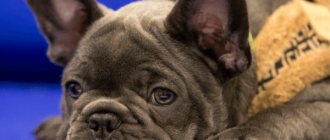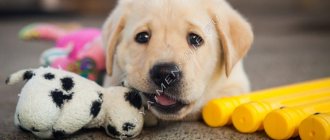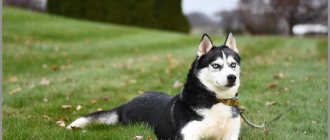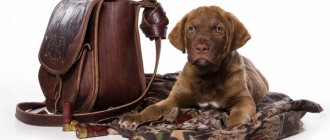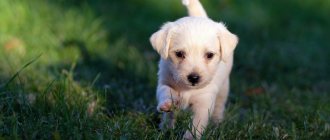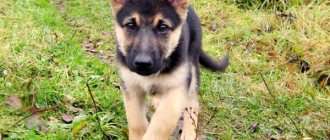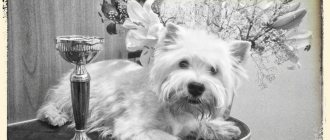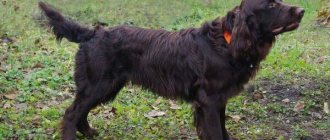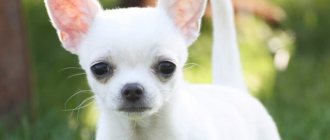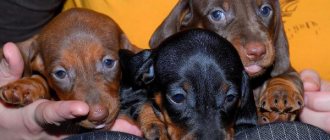Briefly about the breed
Rottweilers are descended from Roman legionnaire dogs that guard military livestock and are similar in appearance to modern Rottweilers and Neapolitan Mastiffs.
The Rottweiler breed developed in the German city of Rottweil to help farmers hold cattle fairs.
Modern representatives of the breed have an average, balanced constitution. Males grow up to 61-70 cm, females - up to 56-65 cm, and the average weight of dogs is 42-50 kg.
Rottweilers have a short, coarse coat with a dense, dense undercoat, colored black with symmetrical patches of red tan located on the cheekbones, eyes, throat, paws and crotch.
Read more about what Rottweilers look like here.
Content
Many people living in apartments and private houses prefer Rottweilers. Let's consider what living conditions are most suitable for these dogs.
In the apartment
Even though the Rottweiler is a large dog, it can still be kept in an apartment. But for a comfortable stay, the dog needs a separate place . In addition, the apartment should be spacious. In a small home it is very difficult to keep up with a large dog; this can slow down its development.
The Rottweiler's task is to protect its owner, so it reacts warily to strangers. It will be difficult to restrain your dog when guests are too close.
On the street
Rottweilers have a thick undercoat, so the dogs can be safely kept outside . But it should be borne in mind that they cannot tolerate heat; care should be taken to ensure comfortable placement in the warm season.
Can you live outside in winter?
Let's consider whether it is possible to keep a Rottweiler outside in winter? The dog endures winter absolutely calmly; it is much easier for him in the cold than in the heat. In addition, excessive exposure to heat negatively affects the condition of the coat. And the apartments are well heated in winter. Therefore, we can conclude that it is better for an animal to live on the street than in an apartment, although the option of keeping it in a multi-storey building should not be completely ruled out.
What kind of frost can it withstand?
The Rottweiler tolerates frost well because it has long hair with a thick undercoat. Therefore, you can safely leave your dog outside in any weather by equipping him with a suitable booth. The Rottweiler can withstand temperatures down to -20 degrees .
Photo
Next in the photo you can see a Rottweiler in winter.
How to care for a puppy?
Even before purchasing a Rottweiler puppy, you should learn about the rules of keeping it and the necessary care by talking with breeders and experienced Rottweiler owners.
To quickly adapt a pet to a new home, it is important to create comfortable conditions for it - equip a personal place, prepare everything necessary for proper care and maintenance:
- combs;
- leash;
- collar;
- muzzle;
- bowls for water and food;
- feeding stand;
- toys.
CAREFULLY!
The puppy should not jump from heights or take hurdles until the musculoskeletal system is fully formed.
At 2-3 months, the puppy needs to be fed 6 times a day, reducing the frequency of feedings as it gets older.
Hygienic care consists of brushing teeth, ears and eyes, trimming nails, washing and combing. The puppy must be taught these manipulations from an early age.
Training at 2 months. Upbringing
At 2 months old, your Rottweiler puppy is still at home, in quarantine after the first vaccinations, and he is not yet allowed to go for walks. Therefore, it’s time to start raising a puppy in the home conditions that are already familiar to him.
Toilet training
The first step is teaching the puppy to go to the toilet in a diaper . You should not rush to teach going to the toilet directly outside, bypassing this stage, because puppies are not physiologically ready for walking twice a day. This ability is developed in Rottweiler puppies no earlier than 6 months, and in some up to 1 year.
You should remember that any learning is a rather complex thing and, seeing the first positive results, you should not think that your puppy has already understood everything, but you should continue training according to the method, so that after a while you do not have to start all over again.
Collar and leash training
The second important point will be to accustom the puppy to a collar and leash . Yes, yes, this should be done at home, so that by the time the puppy goes outside for the first time, wearing a collar will not be additional stress for him, but is already a familiar thing, and he can start exploring the world around him, rather than trying to get rid of an unknown object.
What to allow a puppy and what not
The third point, which causes the greatest difficulty for new puppy owners, will be determining the puppy’s boundaries of what is permitted. Often, many novice dog owners think that the unwanted behavior of a Rottweiler puppy will “go away on its own, outgrow it.” But, unfortunately, the behavior that is allowed for a puppy will be taken for granted later by an adult dog.
.
Any unwanted behavior in a puppy WILL NOT go away on its own, but will only become stronger over time.
Therefore, it is necessary to start defining the puppy’s boundaries of what is permitted now. You will need:
- Teach to play only with your toys, and not with your things;
- Explain that you cannot bite your hands even in a game;
- Establish the correct daily routine, establishing the rule that in the morning you need to sleep and not wake you up;
- Stop chewing furniture, clothes, walls and baseboards;
- Teach to stay home alone, knowing that your absence is not a reason to bark or howl.
IT IS EXTREMELY IMPORTANT TO KNOW: constant and excessive punishments that follow almost every action of the puppy have a detrimental effect on his fragile psyche and can lead to the fact that the Rottweiler puppy grows up cowardly and embittered. For normal natural development, a puppy must have the opportunity to explore the world around him, which is currently limited to your apartment or house.
Introduction to Basic Commands
Already now you should begin to familiarize yourself with the initial obedience commands in a light playful form, while focusing on rewards for execution, because the puppy’s psyche is still quite plastic and excessive severity and exactingness can lead to the puppy being intimidated and cowardly. Therefore, it is necessary, first of all, to try to interest the puppy by offering him a toy or treat, and sometimes just praise.
Caring for an adult dog
Basic care for an adult Rottweiler consists of regular, long walks, active games and balanced feeding, taking into account age and health status.
Regular hygiene procedures are required:
- eye and coat care;
- bathing;
- trimming nails if necessary;
- regular oral examination;
- cleaning teeth and ears.
You also need to promptly deworm and treat for external parasites and vaccinate your pet according to the schedule drawn up by the veterinarian.
Expert opinion
Tolkachev Andrey Mikhailovich
veterinarian
The main thing that Rottweilers need is a balanced diet and the necessary nutritional supplements. They also need proper physical activity. To avoid problems with the musculoskeletal system, a dog up to 8 months should not jump higher than the height of its own elbow, up to a year should not take hurdles, and up to 1.5 years should not run after a bicycle or owner. Your veterinarian should give more detailed recommendations during a routine examination.
Personal place
Keeping a Rottweiler is possible both on the street and in an apartment, if space allows.
If kept outdoors, you will need an equipped spacious enclosure with a booth . It must be insulated, otherwise it is necessary to take the dog into the house if the air temperature drops below -10 °C.
In the case of apartment housing, you need to equip a place for the dog in the far corner of the room, where there are no drafts or heating devices. A warm rug, blanket, mattress or special bed is suitable as a lounger. The main thing is that the size of the bedding should match the size of the pet so that it feels comfortable and can stretch out freely while sleeping.
Street Dweller
Now let’s figure out whether a Rottweiler can live on the street. Living in the courtyard of a private house is an ideal option for a dog of this breed. The main thing is that the fence is high and strong, and the gate closes well. A sudden escape by a Rottweiler can lead to trouble. If a dog mistakes a passerby for an intruder, it will jump over a low fence and bite him.
However, a Rottweiler cannot walk around the yard all the time. An outdoor dog will need his own place. You cannot keep a dog on a chain; this will have a bad effect on its development and psyche. It's better to build an enclosure. You can do it yourself or hire workers. In any case, certain requirements must be met.
What age is best to start?
Puppy training begins at one month of age. Animals are first trained to:
- respond to nickname;
- use a special toilet;
- walk on a leash.
The puppy learns basic skills from its mother. When he is brought to another house, a person begins to be responsible for the fate of the baby. The Rottweiler performs its first commands from the age of two months. You cannot miss moments when your pet stops following orders.
From the very beginning, you need to prevent any antics of the puppy, from which bad habits can form:
- grab hands;
- show aggression towards family members;
- offend other animals.
The owner is your best friend
If a Rottweiler lives in an enclosure, this does not mean that you can forget about him. Lack of attention from the owner and forced loneliness can have a bad effect on the animal’s psyche. The dog will either become depressed or become aggressive.
Regular communication with your dog contributes to its proper development. Feeding, playing, talking - it's wonderful. But the Rottweiler also needs to be released from the enclosure into the yard and even into the house. He must contact all family members. Only in this case will the dog know who and what to protect.
To maintain good physical shape, you need to go for walks outside the fence with your Rottweiler. Fresh air and sunlight strengthen the dog's immune system. And a long run in the park or in the forest helps her get rid of accumulated energy. When going for a walk, be sure to put a muzzle on your Rottweiler.
Now you know how to keep a Rottweiler. If you have anything to add to our article, share your opinion with us.
If you liked the article, please share it with your friends. Don't forget to like.
How to feed?
The diet of Rottweilers can consist of both natural products and ready-made industrial food. At the same time, you cannot mix 2 types of food, and it is necessary to transfer the dog from one diet to another gradually, otherwise there is a risk of problems with the gastrointestinal tract.
The daily diet of a Rottweiler with a natural diet should include:
- proteins, 50% – meat (except pork), fish, eggs, dairy and fermented milk products;
- carbohydrates, 30% – oatmeal, rice, buckwheat porridge;
- fiber, 20% – fruits and vegetables.
A natural diet during active growth of a dog involves daily intake of vitamins and minerals.
If we are talking about ready-made industrial feeds, then they must be premium or super-premium - they contain vitamins and microelements and a balanced amount of proteins, fats, carbohydrates and proteins.
The Royal Canin brand offers food designed specifically for Rottweilers:
- Rottweiler Junior - for puppies;
- Rottweiler Adult - for adult dogs.
Also, breed lines are found in food brands such as:
- Prima;
- Eukanuba;
- Hills;
- Tropheo.
IMPORTANT!
Rottweilers are prone to overeating and obesity, so it is necessary to control portion sizes and follow a feeding schedule.
Self-construction
Before building a pen, the owner must determine the location for its installation. The Labrador is a friendly dog with an excellent sense of smell and keen eyesight. Therefore, the lattice wall of the enclosure should provide a view of the area. Make sure that there are no sewer wells or kitchen hood outlets near the building.
A step-by-step construction plan will help you not to miss important details.
- Place a support made of bricks or concrete masonry to maintain a gap between the floor and the ground. This way you can avoid rotting of the floor boards.
- Weld a metal frame from blanks of the required size. The most convenient material for the base of the structure is a steel profile pipe.
- Lay the floors at a slight angle to the grating to allow rainwater to drain to the ground. Treat them twice with an antifungal solution.
- Build blank walls from stacked wooden panels. Treat them with an antifungal agent. Paint or varnish.
- Build a lattice wall using iron rods. Attach it to the main frame by welding. Prime and paint.
- Install the wooden door so that it opens inward. Attach a latch lock on the outside.
- Lay the roof. For this you can use slate, polycarbonate, roofing felt. The roof should protrude beyond the perimeter of the walls and be equipped with a groove for drainage of precipitation.
We suggest you read: How, when and what to feed rabbits?
Dog breeders do not recommend decorating the enclosure with hanging flower pots or planting flower beds near the structure. The strong aroma of plants will irritate the dog's delicate sense of smell.
Character of Rottweilers
The Rottweiler is an excellent guard; he is always loyal to only one owner. Such dogs are distinguished by fearlessness and courage with a pronounced guard instinct. Knowing their temperament and powerful strength, these animals were often exhibited in dog fights.
The Rottweiler requires special space and a lot of space for active games. He is smart, although he can be capricious and even sometimes aggressive. In training such a dog needs determination and great will. Such dogs are very trainable, although they require significant effort, discipline and constant training.
The Rottweiler is an excellent guard dog and is always devoted to its owner.
Despite their menacing appearance, the Rottweiler loves affection and a gentle attitude, so you can often observe how they persistently try to attract the attention of their owners by nudging their noses into different parts of the body. The most sincere display of love for these animals is a mixture of growls, sighs and wheezes, after which they can put their front paws on their chest and lick their owner from head to toe.
Such a dog is always ready to serve and always subtly senses the change in the owner’s mood, while they always try to console him. This dog can even sometimes be jealous, feeling the owner's sympathy for other people.
A well-trained Rottweiler will be an excellent guard, as well as a loyal and devoted friend. He will always defend his family and his home with determination.
Photo review
Photos of Rottweiler puppies and dogs cannot fail to draw attention to the power, intelligence and charm of these dogs.
Required vaccinations
The innate immunity received by the puppy from its mother protects it from viruses and infections for 2-2.5 months. After this, the puppy requires vaccinations to help develop its own immunity.
Vaccination protects your dog from:
- plague;
- hepatitis A;
- rabies;
- leptospirosis;
- viral enteritis;
- adenovirus;
- parainfluenza.
NOTE!
You cannot vaccinate a puppy during illness, after a recent illness or during the period of teeth change, and before vaccination it is necessary to carry out deworming.
Vaccination and deworming schedule:
- 14-21 days – deworming;
- 4-5 weeks – 1 vaccination, DP -pappi;
- after 10 days – removal of worms;
- 7-8 weeks – 2 vaccinations, DHPPI+L;
- 10-11 weeks – 3 vaccinations, DHPPI+L;
- 14-15 weeks – deworming;
- 6 months – 4 vaccinations, DHPPI +L;
- 8 months – 5th vaccination, Nobivak Rabies rabies vaccine;
- 1 year – 6th vaccination, DHPPI+L.
DHPPI+L and rabies vaccinations must be repeated annually.
Protective guard service
Raising an independent and obedient dog is not an easy task, especially if it is a Rottweiler. Raising a puppy for protective guard duty is an even more difficult task. That is why it is carried out by professional dog handlers.
A cross between a shepherd and a Rottweiler (Malchover): description of the breed
All training is aimed at developing the necessary skills, including security, protection, the ability to look for a trace, etc.
Note! Few people need such courses in everyday life, so these skills are not taught to domestic dogs. If the owner tries to do this on his own, most likely, he will not succeed, but the dog’s psyche will be undermined.
Dog sterilization
If there are no plans for breeding, the dog should be sterilized. It is best to do this before the pet is six months old.
The sterilization procedure not only eliminates the possibility of unwanted pregnancy in females and the possibility of aggressive behavior in males, but also helps to avoid such health problems as:
- testicular cancer;
- prostate problems;
- bladder diseases.
Also, after removal of the ovaries in females, the likelihood of developing breast or uterine cancer is minimized and the risk of developing uterine infections is reduced.
The issue of sterilization should be discussed with a veterinarian during a routine examination of the puppy.
Grooming
The short coat of Rottweilers does not require complex grooming. The pet must be brushed 2 times a week using a dog mitten or a brush with medium-hard natural bristles.
First of all, you need to comb the back, then the stomach, chest, paws and tail, and comb the fur in the genital area and other sensitive areas as carefully as possible.
During the period of seasonal molting, the dog needs to be combed daily, preferably twice a day.
When kept indoors, the Rottweiler sheds throughout the year.
Daily 10-minute brushing not only helps remove dead hair, dirt and dust, but also improves blood circulation and increases muscle tone of the pet.
How to bathe properly?
Rottweilers should be bathed no more than once a quarter, using shampoo for short-haired dogs. The optimal water temperature is 28-30 °C.
Adult dogs can be washed in a communal bath, which then needs to be disinfected, but a small metal bath or basin is suitable for bathing puppies.
Before washing, you need to prevent the possibility of water getting into your ears by placing cotton balls lubricated with Vaseline in them.
First of all, you need to wet the pet's fur, then apply shampoo to it and distribute the foam throughout the body from the neck to the paws. Washing your hair should be the last step.
IMPORTANT!
Soap suds should not be left on the animal's body for a long time - the alkaline additives contained in shampoos can lead to skin irritation.
After washing the Rottweiler, dry it with a soft towel.
Historical reference
The Rottweiler descends from ancient mastiff-like herding dogs. Experts say that breeding began in the 6th century. BC e. in Babylon, from where the breed penetrated into Ancient Egypt, and then became a favorite of the Roman legionnaires, who dressed the Rotti in armor and released it onto the battlefield, terrifying the enemy. Legionnaires brought the dog to Europe, namely to Southern Germany, in the first half of the 2nd millennium BC. e.
The breed received its official calling in 1901 from the First German Union of Police Dogs. In 1914, immigrants from Rottweil entered Russian territory.
Rottweil butchers trusted the guarding qualities of their Rottweilers so much that they hung bags containing the day's earnings around their necks and sent them home. Thanks to the bloodthirsty reputation of the breed, no one dared to approach the brave dogs.
First lessons
Now let's move on to practice and talk about how to properly raise a Rottweiler. From the first day in your home, the puppy should become familiar with its name. This is the key to further achievements. Now we are gradually starting to practice basic obedience skills. Any time you are watching TV, cooking dinner, or watching your puppy frolic, call his name and give the command “Come.” You can lightly slap the leg so that the baby understands what is required of him. Now praise and release with the command “Walk”.
It is equally important to determine your dog's position. It should be comfortable and cozy. On the very first night, put a piece of diaper from the mother's nest into it and give the command “Place”. At first you will have to get up often to calm the baby, stroke it and give warm milk, but then repeat the command and go to bed. So, gradually, the baby develops an image of this world in which you are an adored master, whose word is the law.
Comfortable conditions
The enclosure for a Rottweiler should be cozy. To achieve this, you need to correctly determine the place for it. Choose the driest area in your yard, preferably on a hill. Then, during rains, water will not accumulate inside the enclosure. It’s good if from the chosen place the dog can see most of the yard and the gate.
Consider the direction of the wind - on the side where it most often blows, the dog will be protected by a closed enclosure wall. Part of the enclosure should be in the sun, part in the shade. An important detail is the area of the enclosure. A Rottweiler will need a lot of space and ten square meters will be enough.
It is better to make the floor of the enclosure from concrete so that the Rottweiler does not dig his way to freedom. When pouring the floor, do not forget about a slight slope that allows water to drain - the enclosure must be dry.
If you plan to keep your dog in an enclosure in winter, then you need to lay sanded boards on the concrete. Don't worry, the Rottweiler can withstand up to twenty degrees of frost. However, in severe frosts it is better to take the dog indoors.
In order for the Rottweiler to have visibility, one or two walls of the enclosure must be barred. The mesh will not work - the dog will easily tear it and may break teeth or claws. The remaining walls can be made of brick, metal profiles or smooth wood.
It is better if the door is located in a lattice wall. It should open inward and have two locks: on the inside and on the outside. The roof can be made of slate or metal profiles, the main thing is that there are no gaps. Gaps between the walls and the roof are also not welcome.
Teeth cleaning
Rottweilers are prone to tartar formation and gum disease.
To prevent this, you need to regularly examine your pet’s mouth and brush his teeth weekly with a special toothbrush and toothpaste.
To prevent oral diseases, the dog should be allowed to chew on large raw beef bones or vein bones, sold in pet stores and veterinary pharmacies.
Fresh air is the key to health
The main condition for apartment living is regular walks. The domestic Rottweiler lacks sunlight, fresh air and exercise. Turning a guard dog into a lazy fat dog is not fair to the breed. Moreover, Rottweilers are prone to obesity.
Walks with the puppy are short - half an hour a day. Do not overload your baby’s fragile body with special training. For a puppy, running around the park is enough.
When the baby turns one year old, regular trips increase to one and a half hours. If desired, the dog can be walked longer. Visit special dog parks. There the Rottweiler will be able to get the necessary physical activity by overcoming an obstacle course: barriers, ladders and others.
How to trim claws?
With enough active walks, Rottweilers' claws wear down on their own. If this does not happen, they must be carefully trimmed with a guillotine nail clipper, without touching the blood vessels.
Long claws cause discomfort and pain to your pet and can lead to injuries when walking or playing.
Also, due to constant pain, the dog begins to place its paws incorrectly, as a result of which the load on the joints and ligaments is distributed incorrectly.
An indicator of normal claw length is the absence of their clicking on the floor.
Diseases and life expectancy
Rottweilers are characterized as a strong and healthy breed, practically not susceptible to disease. Their average lifespan is 8-10 years. However, with good care and caring owners, it can be increased to 14-17 years. Rottweilers are prone to eye diseases. For example, with keratitis (inflammation of the cornea), the animal may be afraid of light and cover its eyes, subsequently ulcers and purulent discharge form on the cornea. In addition, Rottweilers are susceptible to:
- joint dysplasia;
- cataracts;
- epilepsy;
- encephalitis;
- skin diseases;
- conjunctivitis.
Limb damage caused by the above diseases is also common in dogs. Your puppy may have shaky paws due to hip dysplasia. The development of osteochondrosis in severe cases can lead to complete failure of the hind legs.
Walking rules
Regardless of where the Rottweiler lives - in an apartment or in an enclosure, for physical, psychological health and socialization he needs daily active walks lasting 1-1.5 hours.
Read about how to teach your dog how to behave while walking.
Lack of physical activity and a sedentary lifestyle lead to joint problems and obesity, aggressive and uncontrollable behavior.
NOTE!
In public places, the dog must be muzzled and on a leash.
TOP nicknames
The puppy receives a “family” name during examination for compliance with breed standards, and you cannot influence his choice. But the passport nickname often remains only in the passport, and in everyday life the name is a reflection of the dog’s character and the owner’s preferences. For Rottweilers, short, sonorous names are often chosen that are related to the history of the origin of the breed, mythology or pop culture.
You can call a Rottweiler “boy”:
- Lord;
- Prince;
- Diesel;
- Archie;
- Hercules;
- Charlie;
- Hugo;
- Oscar;
- Bart;
- Kaiser.
You can name a Rottweiler “girl”:
- Gretel;
- Beauty;
- Adele;
- Buffy;
- Daisy;
- Hera;
- Grace;
- Athena;
- Sabrina;
- Wendy.
Remember, your pet's name should not be similar to team names, similar to popular names in your area, or potentially offensive to others.
Training at 3 months. Socialization
Three months is an important stage in a Rottweiler puppy’s introduction to the outside world. Your first walks should be short and not too tiring for the puppy. You should start with 15 minutes, gradually increasing the walking time to 1 hour.
Correct formation of the nervous system
At this age, the puppy’s nervous system is forming.
. It has been proven that raising puppies in isolation during this important period contributed to the development of pronounced cowardice in them later. It is necessary to show the puppy as much as possible: noisy streets, large crowds of people, etc. Everything that he will have to face in later life.
This must be done very carefully, gradually, over and over again increasing the time spent in noisy places, so as not to overload the puppy or frighten him.
The territory of a country house, cottage or village are places with a minimum amount of external stimuli for a city dog. Therefore, if you plan to keep a dog in an urban environment, “growing up” a Rottweiler puppy in such conditions depleted of irritants is unacceptable.
A city puppy must grow up in the city, in conditions that are saturated with external stimuli, such as: noisy streets, large crowds of people, other animals, birds, cyclists, cars, etc.
Meeting people and dogs
It is necessary to introduce the puppy to friendly dogs and people
so that later the puppy does not develop aggression or cowardice caused by the fear of new things and the inability to communicate and make new acquaintances. Currently, unfortunately, this is not uncommon in the behavior of adult dogs, but a fairly common problem with which people turn to our specialists for help.
Puppy behavior on the street
The emergence of new places leads to new rules that need to be consolidated:
- Now you can and should go to the toilet on the street, and not stoically endure it, carrying everything home;
- Not every new person or dog wants to communicate, so you don’t need to run headlong to meet everyone;
- Not all food is healthy, so it should only be taken from the owner’s hands.
Training and practicing commands
Training a puppy follows the same principles as at 2 months. It should be remembered that at this age puppies develop conditioned reflexes quite easily, but they are forgotten just as quickly, so you should not scold the puppy for not following commands, especially if they have not been repeated for a long time, but you should pay more attention to learning new things and repeating already covered material .
Distinctive features
This breed is distributed throughout the world, which has made its own adjustments to the breed line. There are three main standards: German (truly correct Rottweilers), English (dogs with an imperturbable calm character), American (dogs with increased aggressiveness and the largest sizes).
The correct representative of the breed should be massive and strong. At the withers, dogs reach 60-70 cm and weigh about 50 kg . They do not look light or heavy, although they are large enough and can inspire fear.
The last standard was published in 2000. Breeders monitor the quality of the litter and disqualify all puppies that do not match the characteristics of appearance or temperament.
- The head is not heavy. The skull is long, convex with a pronounced occipital protuberance and brow ridges. A deep stop .
- The muzzle is of medium length, not too wide, tapering towards the nose. The bridge of the nose is straight and horizontal. Cheekbones are clearly visible . The jaws are very strong and wide with a full set of teeth. Scissor bite Lips are dense black.
- The nose is oval, large, black, with open nostrils.
- The eyes are small, almond-shaped, set at stop level. The color of the iris is dark brown.
- The ears are triangular in shape, small, hanging on cartilage, set above the eye line. Cupping for cosmetic purposes is permitted (prohibited in some countries);
- The body is powerful and streamlined. The back is straight and long. The loin is wide, the croup is sloping. The chest is voluminous, deep and wide. The stomach is not tucked in. The neck is of medium length with a convex scruff.
- The tail looks like an extension of the back, hangs in a calm state, reaches the hock joints, and is surrounded by hair. Cupping is allowed.
- The limbs are long, strong, straight, set wide. The feet are round with well-knit toes and strong pads. Movement : wide trot.
- The coat is short, thick, and harsh. The undercoat is shorter than the main coat, dense, retaining heat.
- The color is black with outlined red-red tan markings on the face, chest, paws, and at the base of the tail.
Types of muzzles
This table lists the pros and cons of different types of muzzles:
| Type of muzzle | pros | Minuses |
| Plastic |
|
|
| Metal |
|
|
| Closed leather |
|
|
| Open leather |
|
|
| Nylon |
|
|
Bite protection
The Rottweiler is exactly the kind of dog that needs to be muzzled while walking. This accessory will not allow the animal to pick up dirty objects from the ground, which will protect it from poisoning. Also, a muzzle for a Rottweiler will help to avoid conflict situations with passers-by - many people are afraid of large dogs.
There are many types of muzzles. Suitable for Rottweiler:
- metal mesh;
- closed leather muzzles;
- leather “baskets”;
- plastic;
- bridles.
